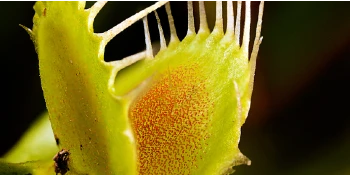The Grounds Guys share essential tips for Venus flytrap care.
|
While the Venus Fly Trap is not the only species of carnivorous plant, though it is arguably the most well-known. These plants are found in areas where the soil has little to no nutritive value which forces them to obtain its food from other sources. If you are looking for a visually interesting, fun addition to your plant collection a Venus Fly Trap may be just what you're looking for—and The Grounds Guys® are pleased to provide you with all the information you need to ensure its health and vitality.

Venus Fly Trap Facts
- Dionaea muscipula, or Venus Fly Trap, can only be found in the coastal bogs of North and South Carolina.
- These plants can live up to 20 years or longer and are considered to be vulnerable to extinction due to the desecration of natural habitation and over-harvesting.
- Venus Fly Traps are perennials and will continue to bloom year after year, producing tiny white flowers decorated with green veins.
- During dormancy, leaves will turn black and the traps will fall off.
- Venus Fly Traps can digest human flesh.
- Each trap will only last through four to six feedings before turning a dark color and falling off.
Caring for Your Venus Fly Trap
Soil
Whether you choose to buy specialized potting soil or make your own, the growing medium must be nutrient-poor, so these plants survive. Regular potting soil will burn the roots as will any type of commercial fertilizer and both should be strictly avoided. A 50/50 blend of peat moss and perlite provides aeration and water retention and be sure to purchase purified forms of peat moss as many brand name products also contain fertilizer.
Water
In nature, the Venus Fly Trap grows in damp soil that has no nutritive value and it will not respond well to tap water which contains minerals including sodium, sulfur, chlorine, magnesium, and more. Carnivorous plants should only be watered with pure water such as distilled, reverse osmosis or rainwater.
These plants prefer soil that is damp but not overly saturated. During the months of active growth, plants should be monitored to ensure the soil doesn't dry out completely while keeping it consistently moist.
During periods of dormancy from November to February, plants should be kept in a cool location and the soil allowed to become almost dry before watering.
Light
During the months of active growth, plants should receive a minimum of four hours of direct light and at least 12 hours of light. A bright, south facing window ledge is the ideal location, but during periods of dormancy, the same window ledge will likely be too warm. Move the plant to a cooler location such as an unheated greenhouse or beside a window in the garage, and don't forget to provide water.
Feeding
A Venus Fly Trap can distinguish between food and non-food items and won't spend the energy closing the trap on something not considered to be prey. Each trap has six trigger hairs, three on each side, and two of them must be tickled so the plant can spring into action.
Once it has closed the trap seals tightly to prevent the prey from escaping, and the digestive process begins. In approximately 10 days the process is complete, and the trap reopens to discard the husk.
Most plants can sustain themselves on their own with common household insects, but if you choose to feed it yourself use only live or dead insects, resisting the urge to give it raw meat which will only kill the plant.
Need Professional Landscaping Assistance?
The Grounds Guys knows plants, trees, lawn, mulch and more! Need help with your fall clean up or want to plan your spring landscaping projects? Contact The Grounds Guys franchise location near you!